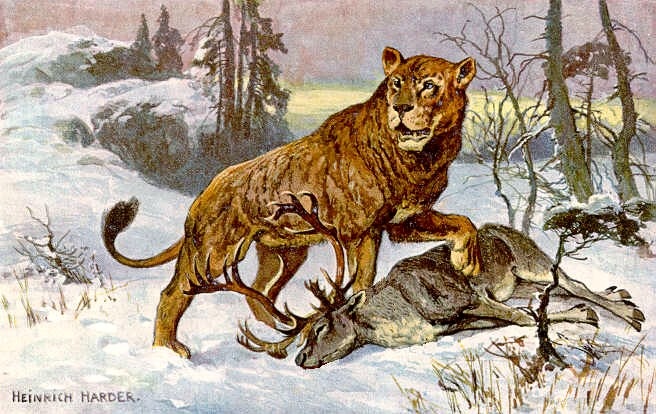- Cave Lion
Taxobox
name = Cave lion
fossil_range = Middle to LatePleistocene

image_width = 250px
regnum =Animal ia
phylum = Chordata
classis =Mammal ia
ordo =Carnivora
familia =Felidae
genus = "Panthera "
species = "P. leo"
subspecies= †"P. l. spelaea"
trinomial = "Panthera leo spelaea"
trinomial_authority = Goldfuss, 1810The cave lion "(Panthera leo spelaea)" also known as the European or Eurasian cave lion, is an
extinct subspecies oflion known fromfossil s and multiple examples ofprehistoric art .Physical characteristics
This subspecies was one of the largest lions. The remains of an adult male, which was found in 1985 near
Siegsdorf inGermany , had a shoulder height of around 1.2 m (4 feet) and a body length of 2.1 m (7 feet) without including the tail. This is similar to the size of a very large modern lion. The size of this male has been exceeded by other specimens of this subspecies. Therefore this cat may have been approximately 5-33% larger than modern lions, and maybe even larger than the largest extant cat, theSiberian tiger , "Panthera tigris altaica", but it was smaller than the earlier cave lion subspecies, "Panthera leo fossilis ", and the even largerAmerican lion , "Panthera leo atrox" Lessem, D. 1999. "Dinosaurs to dodos. An encyclopedia of extinct animals". Scholastic, New York. 122pp.] [ W. v. Koenigswald: Lebendige Eiszeit. Theiss-Verlag, 2002. ISBN 3-8062-1734-3 ] . Their body colour possibly varied from aochre -tinted grey to dark ochre brown on the upperparts of the body, while the rest of the coat was light brown.The cave lion is known from
Paleolithic cave paintings ,ivory carvings, and clayfigurine s. These representations indicate that cave lions had rounded, protruding ears, tufted tails, possibly faint tiger-like stripes, and that at least some had a "ruff" or primitive mane around their neck, indicating males. Other archaeological artifacts indicate that they were featured in Paleolithic religious rituals.Environment
The cave lion received its common name from the fact that large quantities of its remains are found in caves Arduini, P. & Teruzzi, G. 1993. "The MacDonald encyclopedia of fossils". Little, Brown and Company, London. 320pp.] , but it is doubtful whether they lived in them. It had a wide habitat tolerance, but probably preferred conifer forests and grasslands Hublin, J.-J. 1984. "The Hamlyn encyclopedia of prehistoric animals". Hamlyn, London. 318pp.] , where medium-sized to large herbivores occurred. Fossil footprints of lions, which were found together with those of
reindeer , demonstrate that these cats once occurred even in subpolar climates.These active carnivores likely preyed upon the large, herbivorous animals of their time, including horses, deer and
bison . Some paintings of them in caves show several hunting together, which suggests the hunting strategy of contemporary lionesses.Small prey was usually brought down with a blow of the front paw and then held down with both front feet. The animal was finally killed by a powerful bite of the sharp teeth , at the back of the neck, in the region of the throat and even in the chest. A cave lion usually could not run as fast as its prey, but could pounce on it from behind or run up next to it and bring it down with the paws. In this manner a running animal's balance could very easily be disturbed.
It was most likley the most common predator (after the cave hyena) in plains ecosystems. Its extinction may have been related to the
Quaternary extinction event , which wiped out most of themegafauna prey in those regions. Cave paintings and remains found in the refuse piles of ancient camp sites indicate that they were hunted by early humans, which also may have contributed to their demise.Classification
The cave lion is normally considered a
subspecies of lion, with the scientific name of "Panthera leo spelaea" (which means "cave lion" inLatin ); but occasionally, it is considered aspecies in its own right, under the name "Panthera spelaea". At least one authority, based on a comparison ofskull shapes, considers the cave lion to be more closely related to thetiger , which would result in the formal name "Panthera tigris spelaea" [Groiss, J. Th. (1996): "Der Höhlentiger" Panthera tigris spelaea "(Goldfuss)". Neues Jahrb. Geol. Paläont. Mh. Vol.7, p.399–414.] , however, recent genetic research [Burger, Joachim "et al." (2004): "Molecular phylogeny of the extinct cave lion" Panthera leo spelaea. Mol. Phylogenet. Evol. Vol.30, p.841-849. ] shows that it was a close, but separate, relative of the modern lion.History and distribution
The cave lion ("Panthera leo spelea") was derived from the earlier subspecies "
Panthera leo fossilis ", which first appeared in Europe about 700,000 years ago. The cave lion itself lived from 370,000 to 10,000 years ago, during thePleistocene epoch. Apparently, it became extinct about 10,000 years ago , during theWürm glaciation , although there are some indications it may have existed into historic times in southeastern Europe, as recently as 2,000 years ago in theBalkans . [ Wild cats of the world by C A W Guggisberg (1975) ISBN 0800883241 and Pleistocene mammals of Europe by Björn Kurtén (1968) [not seen] ]Cave lions were widespread in parts of
Europe andAsia , fromGreat Britain ,Germany andFrance (Arduini & Teruzzi, 1993) all the way to theBering Strait and fromSiberia toTurkistan .References
ee also
*
Panthera leo fossilis
*Panthera leo vereshchagini
*Panthera leo atrox
*Panthera leo In Popular Culture
The Cave Lion is represented as characters and as a revered totemic spirit in the
Earth's Children series of prehistoric fiction, byJean M. Auel . It appears in the computer game .External links
* [http://www.messybeast.com/cat-prehistory.htm Prehistoric cats and prehistoric cat-like creatures] , from the Messybeast Cat Resource Archive.
* [http://www.beringia.com/02/02maina5.html American lion] , by C. R. Harrington, from Yukon Beringia Interpretative Center.
* [http://hanskrause.de/HKHPE/hkhpe_11_02.htm The mammoth and the flood] , volume 5, chapter 1, by Hans Krause.
* [http://dml.cmnh.org/1996Aug/msg00152.html Hoyle and cavetigers] , from the Dinosaur Mailing List. (Groiss)
* [http://www.worldmuseumofman.org/cavelion.htm The Interaction of the European Cave Lion and Primitive Humans]
Wikimedia Foundation. 2010.
